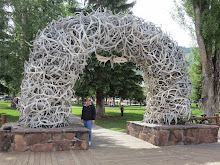Wednesday, June 16, 2010
The power of the JUJU!
At last observance on June 13th the JuJu appears to be working. It is fading from it's bright orange color so we are hoping that the magic is not in the color but rather it's wiggling above the bimini cover that keeps the seagulls at bay!!
Tuesday, June 1, 2010
Damn you Seagull!!!
Glaucous-Winged Gull (Larus glaucescens)
The Glaucous-Winged Gull is named for its gray wings; the greek word “glaukos” means blue-gray. It is a large bird (although smaller than a Glaucous Gull) whose body will reach roughly 20-23 inches (50-59 cm) as an adult. Their wingspan can reach 47-56 inches (120-143 cm) in length. They have a white head and underparts, but unlike the Glaucous Gull however, the Glaucous-Winged Gull had medium gray wings. Like the Glaucous Gull, the Glaucous-Winged Gull also has a yellow bill with a red spot near the tip of the lower mandible. The Glaucous-Winged Gull is a “four-year gull,” in that it takes four years to reach adult plumage.Nesting is usually in colonies where the chicks are safest from predators, and birds first breed at four years of age.. Nests are usually on the ground or in protected rocky formations. The nest is a shallow depression with a ring of vegetation and nearby debris. Both parents incubate the 2-3 eggs for about four weeks. Newborn chicks are covered in down and may leave the nest as soon as two days post-hatching, although they stay near the nest where the parents can protect them. Both parents feed the young, which first begin to fly at 5-7 weeks old, and then leave the colony about 2 weeks after they've learned to fly.Glaucous-Winged Gull's are found all along the Pacific Northwest coastline. Glaucous Winged Gulls are omnivores (they will eat most anything), their diet includes fish and other marine creatures, small birds, eggs, small mammals, invertebrates, and in populated areas, refuse from dumps, trash cans, and parking lots. Glaucous-Winged Gulls migrate south from Alaska going as far south as the Baja Peninsula of Mexico.
More than you probably wanted to know about seagulls. One (or 2) have taken to sitting on the bimini cover of the flybridge. I have highlighted their diet info as we are seeing the after effects of their diet. In huge quantities!!
After reading various blogs about how to get them to alter their behavior, in this case "Get off our boat, bird!!, we took off for a toy store looking for that old childhood toy, the pinwheel. But my husband spotted another object which he has named the JUJU. Picture to be posted later. Imagine a long rubber wiggly object. Now picture it strung between the aerials above the flybridge cover on the boat on fishing line bobbing up and down, all intended to keep the gull off the boat!!! Will it work????
The Glaucous-Winged Gull is named for its gray wings; the greek word “glaukos” means blue-gray. It is a large bird (although smaller than a Glaucous Gull) whose body will reach roughly 20-23 inches (50-59 cm) as an adult. Their wingspan can reach 47-56 inches (120-143 cm) in length. They have a white head and underparts, but unlike the Glaucous Gull however, the Glaucous-Winged Gull had medium gray wings. Like the Glaucous Gull, the Glaucous-Winged Gull also has a yellow bill with a red spot near the tip of the lower mandible. The Glaucous-Winged Gull is a “four-year gull,” in that it takes four years to reach adult plumage.Nesting is usually in colonies where the chicks are safest from predators, and birds first breed at four years of age.. Nests are usually on the ground or in protected rocky formations. The nest is a shallow depression with a ring of vegetation and nearby debris. Both parents incubate the 2-3 eggs for about four weeks. Newborn chicks are covered in down and may leave the nest as soon as two days post-hatching, although they stay near the nest where the parents can protect them. Both parents feed the young, which first begin to fly at 5-7 weeks old, and then leave the colony about 2 weeks after they've learned to fly.Glaucous-Winged Gull's are found all along the Pacific Northwest coastline. Glaucous Winged Gulls are omnivores (they will eat most anything), their diet includes fish and other marine creatures, small birds, eggs, small mammals, invertebrates, and in populated areas, refuse from dumps, trash cans, and parking lots. Glaucous-Winged Gulls migrate south from Alaska going as far south as the Baja Peninsula of Mexico.
More than you probably wanted to know about seagulls. One (or 2) have taken to sitting on the bimini cover of the flybridge. I have highlighted their diet info as we are seeing the after effects of their diet. In huge quantities!!
After reading various blogs about how to get them to alter their behavior, in this case "Get off our boat, bird!!, we took off for a toy store looking for that old childhood toy, the pinwheel. But my husband spotted another object which he has named the JUJU. Picture to be posted later. Imagine a long rubber wiggly object. Now picture it strung between the aerials above the flybridge cover on the boat on fishing line bobbing up and down, all intended to keep the gull off the boat!!! Will it work????
Subscribe to:
Comments (Atom)
